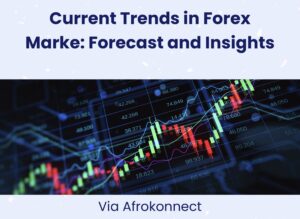This post is about the Current Trends in Forex Market with Forecasts and Insights, via Afrokonnect. You’re witnessing a forex market influenced by key trends.
Geopolitical events like trade sanctions and diplomatic developments cause currency fluctuations between 5-10%. Technological innovations such as algorithmic trading and blockchain integration enhance market speed and security.
Keep an eye on economic indicators like interest rates and employment data to predict currency movements. Central bank policies, including interest rate adjustments and quantitative easing, greatly impact forex trading.
Emerging markets offer both opportunities and volatility, often driven by political instability and trade imbalances. Understanding these data-driven insights helps you navigate the complex forex landscape more effectively. There’s more to explore if you’re intrigued, whether it’s understanding these dynamics to start a forex brokerage or leveraging them for strategic trading decisions.
Geopolitical Influences
Geopolitical events greatly impact the forex market by causing shifts in currency values and altering trading dynamics. When countries impose trade sanctions, it directly affects their currency’s strength. For instance, if the United States enforces trade sanctions on a country, that nation’s currency typically depreciates due to reduced export revenues and increased economic uncertainty. This depreciation can be quantified; historical data shows that sanctioned countries often experience a currency drop of about 5-10% within the first three months.
Diplomatic relations also play an essential role. Positive diplomatic developments between nations can lead to currency appreciation. For example, when two major economies announce improved trade agreements, their respective currencies often strengthen. A notable case is the improved diplomatic relations between the European Union and Japan, which led to a 3% appreciation of the Euro against the Yen within a month.
You can track these geopolitical events to forecast currency movements. By analyzing the data, you’ll see clear patterns: trade sanctions lead to depreciation, while positive diplomatic relations tend to cause appreciation. Understanding these relationships can enhance your trading strategies and improve your forex market predictions.
Technological Innovations
Technological innovations have revolutionized the forex market by enhancing trading efficiency, improving data analysis, and providing advanced tools for better decision-making.
One significant advancement is algorithmic trading. By leveraging sophisticated algorithms, you can execute trades at lightning speed, capitalizing on even the smallest price discrepancies. This automation reduces human error, guarantees consistency, and allows you to backtest strategies with historical data, enhancing your confidence in their potential profitability.
Another game-changer is blockchain integration. Blockchain technology offers unparalleled transparency and security in transaction processing. For you, this means reduced risk of fraud and a higher level of trust in the system. Additionally, blockchain’s decentralized nature can simplify complex transactions, lowering costs and speeding up settlement times.
Data analytics tools have also evolved, offering real-time insights and predictive analytics. You can now analyze vast amounts of market data quickly, identifying trends and making informed decisions. These tools enable you to assess market volatility, liquidity, and sentiment with unprecedented accuracy.
Economic Indicators
Economic indicators play an essential role in forex trading by providing you with data-driven insights that can forecast currency movements and inform strategic decisions. Interest rates are among the most influential economic indicators. When a country’s central bank raises interest rates, its currency typically appreciates due to the higher returns on investments denominated in that currency. Conversely, lower interest rates can lead to currency depreciation. Monitoring central bank announcements and economic reports can help you anticipate these changes.
Employment data is another critical indicator. High employment levels generally signal a robust economy, leading to stronger currency values. For instance, the Non-Farm Payrolls (NFP) report in the U.S. often causes significant market fluctuations. A higher-than-expected NFP number can boost the U.S. dollar as it indicates economic growth, while a lower figure may weaken it. Keeping an eye on unemployment rates and job creation statistics can provide you with valuable insights into economic health.
Analyzing these indicators allows you to make informed trading decisions. By understanding the implications of interest rates and employment data, you can better predict currency trends and optimize your forex trading strategies. Data-driven analysis is essential for staying ahead in the dynamic forex market.
Central Bank Policies
Central bank policies are pivotal in shaping forex market dynamics by directly influencing currency values through interest rate adjustments and monetary interventions. When central banks like the Federal Reserve, European Central Bank, or Bank of Japan alter interest rates, you can observe immediate impacts on forex trading.
For example, an interest rate hike typically strengthens a currency as higher rates attract foreign capital seeking better returns. Conversely, rate cuts can devalue a currency, as investors look for more lucrative opportunities elsewhere.
Monetary policy extends beyond mere interest rate changes. Quantitative easing (QE) and other forms of monetary intervention also play significant roles. In periods of economic downturn, central banks may implement QE, injecting liquidity into the financial system. This often leads to currency depreciation, as increased money supply reduces its value.
You should monitor central bank announcements and policy minutes closely, as these provide critical insights into future monetary policy directions. Historical data shows that currencies react not just to actual changes but to forward guidance as well.
For instance, even the hint of a future rate adjustment can sway market sentiment, affecting currency pairs well in advance of any policy action.
Emerging Market Dynamics
While central bank policies wield significant influence over major currencies, emerging market dynamics present their own set of unique challenges and opportunities for forex traders. You’ll find that currency volatility in these markets often stems from a variety of factors, including political instability, economic policy shifts, and trade imbalances.
For instance, countries with significant trade deficits, like Turkey or Argentina, frequently experience sharp currency depreciation. This happens as a result of capital outflows and a lack of investor confidence.
Moreover, emerging markets are often subject to rapid changes in investor sentiment, which can lead to sudden and unpredictable currency movements. If you’re trading currencies like the Brazilian Real or the South African Rand, you’ll need to closely monitor geopolitical events and economic indicators. Data such as inflation rates, GDP growth, and foreign exchange reserves are vital for evaluating potential risks and rewards.
You should also consider how trade imbalances impact currency volatility. Countries with large trade surpluses, such as China, might see their currencies appreciate due to increased demand for their exports. Conversely, nations with trade deficits may face downward pressure on their currencies.
Conclusion

In analyzing the forex market, you’ll find that geopolitical influences and technological innovations are pivotal. Economic indicators and central bank policies provide essential data that steer currency values.
Don’t overlook emerging market dynamics, as they offer unique opportunities and risks. By staying informed and leveraging detailed, data-driven insights, you can navigate the complexities of forex trading more effectively.
Your strategic decisions will benefit from understanding these key elements shaping the current market landscape.















